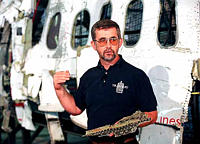
Peter Parsons / Herald Photo
Don Enns, an
investigator with the Transportation Safety Board of Canada,
looks over the landing-gear section of Swissair Flight 111 at
CFB Shearwater on Thursday.
| Investigators
face massive task
Team of experts trying to
put Flight 111 back together
By Lois Legge / Staff
Reporter
It looks like a massive autobody shop. Metal cylinders, tangled
air ducts, damaged valves and fuel pumps lie atop plywood tables.
Wiring in all sizes and colours sits in a large box or hangs from
frames.
But the engineers and investigators inside Hangar A at Canadian
Forces Base Shearwater have a job much more complicated than
assembling car parts.
And their ultimate goal is to find out why 229 people died.
For months, they've been sifting through the remnants of Swissair
Flight 111, the Boeing MD-11 that crashed off Nova Scotia on Sept.2,
killing all passengers and crew aboard and shattering the aircraft
into more than a million pieces.
Vic Gerden, chief investigator for the Transportation Safety
Board of Canada, and his colleagues showed reporters Thursday how
they are trying to connect those pieces to solve the puzzle and
prevent a future disaster.
Mr. Gerden revealed little new information Thursday about what
may have caused the crash, but he and fellow investigators made one
thing clear - their job in an already $62-million investigation is
far from over.
The probe is zeroing in on what caused smoke in the cockpit 16
minutes before the plane plunged into St. Margarets Bay.
In HangarA, investigators are reconstructing sections of the
front part of the plane, vital to solving the mystery because that's
where the heat damage is concentrated. Temperatures there reached
some 600 C.
A nine-metre metal frame - a full-scale mockup of the area
extending back from the cockpit to the beginning of the first-class
section - already includes some pieces of the plane.
A large section of fuselage has been attached to one side, five
windows clearly visible.
Inside the frame, reconstructed wiring, air ducts and other
pieces have been tied to the jig.
Yet more pieces of the forward section - the main cockpit
instruments; three galleys, one with clearly visible heat damage on
the ceiling; and wires - have been assembled on the floor or on
tables in the hangar.
"We are using the frame as a tool to assess the origin of the
heat," Mr. Gerden said.
But the task is extremely difficult because many of the pieces
are so tiny that investigators must first discover what they are and
where they belong.
So far, they've found 13 wires - out of 250 kilometres of wiring
aboard the MD-11 - that show signs of arc-tracking, which occurs
when insulation covering wire bundles breaks down. Arc-tracking can
spark a massive fire along the rest of the wires.
Seven of the arced wires came from the plane's high-tech inflight
entertainment system.
But whether wiring actually caused a fire aboard Flight 111 still
isn't clear.
"We still do not have an analysis ... of whether the arcing was
the origin of the fire or whether there was a fire that damaged the
wires, therefore removing insulation which caused the arcing," Mr.
Gerden said.
Investigators hope to find more damaged wiring among the 11 per
cent of the aircraft still underwater. Of the wires found so far,
many were broken apart by the devastating impact of the nose-first
crash.
Standing next to a box of wiring, investigator Jim Foot holds up
an arc-damaged piece a little longer than his index finger.
"When you start off with a box of wire like this, this is the
needle in the haystack," he said.
Mr. Gerden said investigators are using every tool at their
disposable, from virtual reality-type computer mockups to heat tests
that show what charring by the most intense heat looks like.
Most of the 89 per cent of the jet recovered - totalling 115,000
kilograms - sits elsewhere.
Larger pieces without heat damage, including the MD-11's mangled
landing gear, wings and pieces of fuselage, are stored in an open
compound next to Hangar J. Inside, three large engines accompany 650
boxes containing everything from carpeting to bits of fuselage.
Reminders of the vast human tragedy are found in simple words
marked in cardboard: Life Rafts and Survival Kits, items the
passengers never got to use. |